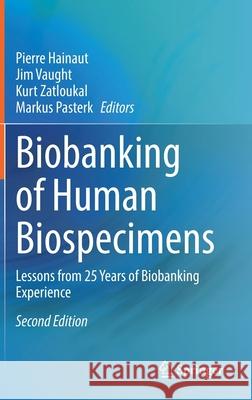Biobanking of Human Biospecimens: Lessons from 25 Years of Biobanking Experience » książka



Biobanking of Human Biospecimens: Lessons from 25 Years of Biobanking Experience
ISBN-13: 9783030559007 / Angielski / Twarda / 2021 / 205 str.
Biobanking of Human Biospecimens: Lessons from 25 Years of Biobanking Experience
ISBN-13: 9783030559007 / Angielski / Twarda / 2021 / 205 str.
(netto: 537,98 VAT: 5%)
Najniższa cena z 30 dni: 539,74
ok. 22 dni roboczych.
Darmowa dostawa!
1. Biobanking for Biomarker Discovery
2. Biobank design and infrastructure: Biobank Engineering
3. Biocomputing for biobanks: Workflow and information management systems for biobanks
4. Tissue Preservation and Factors Affecting Tissue Quality5. The use of paraffin blocks/pathology archives for clinical biobanking
6. Biobanking Best Practices and Publication Standards
7. Ethical challenges for biobanks – two sides of the coin8. Ten years of experience in training Biobank Managers at Master level in France.
9. National biobank networking: The case of Spain
10. Public-private Partnership in Biobanking: The Model of the BBMRI-ERIC Expert Centres
11. The future of biobanking: meeting tomorrow’s challenges
Pierre Hainaut, Ph.D., is Professor of Cancer Biology at University Grenoble-Alpes, France. As head of Molecular Carcinogenesis at the International Agency for Research on Cancer (IARC, World Health Organization), he has led the development of international standards for biobanking in molecular epidemiology and pathology, and has been involved in projects implementing biomarkers in molecular epidemiological studies in different parts of the world. Since 2015, he is Director of the Institute for Advanced Biosciences, a joint research center of the French National Institute of Health and Medical Research (INSERM), National Center for Scientific Research (CNRS) and Université Grenoble-Alpes, dedicated to Epigenetics, Environment, Cell Plasticity and Cancer. He is President of Cancerople CLARA, a structure that coordinates research and innovation on cancer across the Auvergne Rhône Alpes Region in France.
Jim Vaught, Ph.D., spent 14 years at the U.S. National Cancer Institute, most recently as the Chief of the Biorepositories and Biospecimen Research Branch. He has been working in the field of biobanking and biospecimen science for over 20 years. In 1999, he was one of the founding members of the International Society for Biological and Environmental Repositories (ISBER) and served two terms as its president. He is a Senior Research Fellow at the International Prevention Research Institute in Lyon. He is the current Editor-in-Chief of Biopreservation and Biobanking, the official journal of ISBER. In 2017 he was appointed as a Guest Professor at Central South University in Changsha China, where he is a lecturer for a post-graduate biobanking course. In 2018 he was appointed as a Guest Professor at Children’s Hospital of Shanghai.
Kurt Zatloukal, MD, is Professor of Pathology at the Medical University of Graz. He coordinated the preparatory phase of a European biobanking and biomolecular resources research infrastructure (BBMRI) within the 7th EU framework programme, and is the Austrian National Node Director of BBMRI. His research fields are molecular pathology of liver diseases and cancer, and the development of biobanking as well as data management technologies. He is member of the Austrian Standards Institute and CEN and ISO technical committees contributing to several ISO standards related to sample pre-analytics and molecular diagnostics.
Markus Pasterk is Senior Special Projects Officer at the Austrian Federal Ministry of Education, Science and Research and Senior Advisor for X-Officio, Lund, Sweden. He is also Senior consultant for International Relations at the Austrian Drug Screening Institute in Austria and Visiting Professor at the University of Milano-Bicocca in Italy. Before that he was CEO of ADSI (2018-2019) and Administrative Director of BBMRI-ERIC, the pan-European Research Infrastructure for Biobanking and Biomolecular Resources with Headquarters in Graz, Austria from 2014-2018 as well as Chief Operating Officer and Vice President/Science, at the International Prevention Research Institute in Lyon, France 2009-2013 and Scientific Coordinator of the International Agency for Research of Cancer in Lyon, France 2006-2009. He is an expert in research & development policy and teaches Financial Management of International Research Infrastructures.
Over the past 25 years, biobanks of human specimens have become a cornerstone for research on human health and have empowered the “omics “revolution that characterizes biomedical science in the 21st Century. Today, biobanking of human specimens is a critical component of the interface between clinical practice and translational research, supporting the discovery and validation of new biomarkers of disease etiology, risk, early detection, diagnosis, prognosis, prediction and relapse. With the development of personalized medicine, biobanking of cryopreserved specimens has become standard practice in order to investigate genetic, transcriptomic, proteomic, metabolomics and immunological biomarkers useful to inform caregivers for therapeutic decisions.This book is the first comprehensive text on the market about human biobanking, and is a timely follow up to the editor’s 2017 volume Biobanking of Human Biospecimens: Principles and Practice. Written by leading scientists and regulatory officers in the field, the books can be read and used independently, but together, offer a deep understanding of all aspects of human biobanking as a central practice for research and medicine. The aim of the two volumes is to provide a published “one-stop shop” for state-of-the-art information on what constitutes the field of human biobanking, from conception of a biobank, standard operating procedures, ethical and societal aspects, governance, networking, interoperability and economic sustainability. This inclusive publication concept meets the needs of a vast readership, including scientists, doctors and technical staffs who are directly involved in biobanking operations, scientists in other disciplines that heavily rely on biobanking (such as genomics or proteomics), stakeholders and policy makers, and students for whom biobanking is becoming an important part of the training curriculum.
1997-2026 DolnySlask.com Agencja Internetowa
KrainaKsiazek.PL - Księgarnia Internetowa









